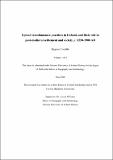| dc.contributor.advisor | O'Conor, Kieran | |
| dc.contributor.author | Costello, Eugene | |
| dc.date.accessioned | 2016-06-09T08:33:57Z | |
| dc.date.issued | 2016-06-07 | |
| dc.identifier.uri | http://hdl.handle.net/10379/5870 | |
| dc.description.abstract | This thesis creates a new understanding of the phenomenon of transhumance in post-medieval Ireland, c.1550-1900 AD. Transhumance is an agro-pastoral system in which people and their livestock spend several months of each year on marginal land away from the main settlement. In Ireland, it mainly saw the movement of dairy cows to summer upland pastures. This is the first nationwide study of Irish transhumance and its archaeological legacy. It presents the results of field survey in the Galtee Mountains, Cos. Limerick/Tipperary, Iorras Aithneach, Co. Galway, and Gleann Cholm Cille, Co. Donegal. Almost one hundred sites have been discovered, most of which are likely to be the remains of booley houses – the summer upland dwellings of herders tending to and milking dairy cows. By examining field data in the context of ethnographic and historical evidence, it is shown that there are significant differences in Irish transhumance over time and space. Only a minority of people actually re-located to summer pastures, with numbers being particularly low by the nineteenth century. This decline was caused partly by rapid population growth in the eighteenth and nineteenth centuries, leading to encroachment on commonage, and partly by economic developments. In the sixteenth and seventeenth centuries, transhumance had been more widespread around the country. The landscapes of seasonal settlement reveal much about the social organisation of transhumant communities and how they changed over the course of the post-medieval period. Differences in the distribution, size and design of booley houses are clearly linked to changes in home settlements. This thesis gives voice to non-elite farmers who were constantly making and responding to socio-economic circumstances in evolving agricultural landscapes. As such, it forms an important case-study in the application of archaeological methods to the study of the complex relationship that human societies maintain with both livestock and landscape. | en_IE |
| dc.rights | Attribution-NonCommercial-NoDerivs 3.0 Ireland | |
| dc.rights.uri | https://creativecommons.org/licenses/by-nc-nd/3.0/ie/ | |
| dc.subject | Transhumance | en_IE |
| dc.subject | Booley | en_IE |
| dc.subject | Seasonal movement | en_IE |
| dc.subject | Upland archaeology | en_IE |
| dc.subject | Settlement patterns | en_IE |
| dc.subject | Population pressure | en_IE |
| dc.subject | Post-medieval Ireland | en_IE |
| dc.subject | Cattle | en_IE |
| dc.subject | Summer grazing | en_IE |
| dc.subject | Commons | en_IE |
| dc.subject | Pastoralism | en_IE |
| dc.subject | House morphology | en_IE |
| dc.subject | Archaeology | en_IE |
| dc.title | Upland transhumance practices in Ireland, and their role in post-medieval settlement and society, c.1550-1900 AD | en_IE |
| dc.type | Thesis | en_IE |
| dc.contributor.funder | Irish Research Council | en_IE |
| dc.contributor.funder | NUI Galway Hardiman Scholarship | en_IE |
| dc.local.note | This thesis uses archaeology, folklore and historical sources to explain how the seasonal movement of people and their livestock (i.e. transhumance) played an important but declining role in Irish farming and rural settlement from the mid-1500's up to about 1900. | en_IE |
| dc.description.embargo | 2024-06-07 | |
| dc.local.final | Yes | en_IE |
| nui.item.downloads | 1 | |


